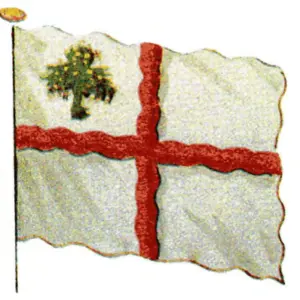Some time ago, one of our writers Gregory Pettys brought us the story behind Westerly’s official seal and the flag that it appears upon. However, there is another flag that has long flown over Westerly: the official flag of the State of Rhode Island and Providence Plantations. Over the last 333 years, several flags have represented both the Colony and State of Rhode Island, both officially and unofficially.
Before diving into the history of these state flags, it is important to first introduce some specific terms which will help to better understand these flags.
- Hoist– The half or edge nearest the flagpole.
- Fly– The half or edge farthest from the flagpole.
- Pike– Another term for the flagpole. This term is important for Rhode Island flags as the most recent legislation establishing a state flag uses the term pike as opposed to more common terms.
- Field– The background of a flag behind figures and symbols
- Canton– a quarter of the flag, most commonly signifying the upper hoist quarter, similar to the stars in the United States flag.
Now, we are ready to cover the history of Rhode Island’s flags. The first of these is the flag of New England.
The Flag of New England, 1686-1707
Although it was not exclusively a symbol of the colony of Rhode Island, the flag of New England, which is said to have first appeared in the late 17th century, was likely the first flag to be flown in Rhode Island and, perhaps, Westerly. The flag initially was represented in 1686 in a drawing made by a British officer named John Graydon who painted an image of the flag of New England in an extant manuscript found in the collections of Magdalene College in England.
(See Figure 1) This painting showed the flag as a white flag with a red cross and a green tree in the canton. [1] As early as 1693, a red flag with the flag exhibited by Graydon in the canton was used by colonial merchant ships sailing out of New England ports. [2] (see Figure 2)
Despite Graydon’s earlier depiction, it was the 1693 version which came to be identified with New England. For several decades, the flag was used on ships, many leaving from the Massachusetts Bay Colony, but also from the other colonies of New England. [4]
This particular flag appeared on flag charts printed in 1693, 1701, and 1705, indicating its status as an accepted symbol of the region. [5] In 1707, Queen Anne of England decreed that the only legal flag to be flown on ships of her Majesty’s colonies was the “red ensign” a red flag with a canton depicting the union jack flag which is still used by the United Kingdom today.[6]
For much of the 18th century, flags were flown almost exclusively at sea, and therefore, it was not until the Revolutionary War when a Rhode Island-specific flag would be flown on land.
Two Rhode Island Regiment Flags, 1775-1781
During the Revolutionary War, there were two flags representing the colony of Rhode Island that appeared on the battlefield. The first of these was the flag of the First Rhode Island Regiment. This flag had a canton of thirteen stars in a field of navy blue. The field of this flag was white and contained a navy anchor and rope with the word “HOPE.”[7]
(See Figure 3) The earliest version of this flag, in which the words “R. Island Reg’t.” are painted, was, at one time, displayed in the Rhode Island State House. There is no official documentation to establish when this flag first appeared, but one source states “there is good reason for believing that it was carried from Rhode Island by the “army of observation” when it marched in 1775 to join the Continental army gathering about Boston to besiege the British army.” [8] This same flag was on the battlefield at Long Island, Harlem, White Plains, Trenton, Princeton, Brandywine, Germantown, Monmouth, Rhode Island and Yorktown.[9]
There is quite a bit of debate and uncertainty, however, regarding a flag that was carried by the Second Rhode Island Regiment. Some historians have proclaimed that the above-mentioned flag of the First Rhode Island Regiment was actually that of the Second Regiment. Another source suggests that the Second Regiment flag was a plain flag bearing the words “SECOND RHODE ISLAND REGIMENT.”
The colors of this flag and the source of this information is not provided. [10] Regardless of the appearance of the Second RI Regiment flag, it is doubtful that the flag of either regiment flew over Westerly at any time, although for the duration of the war, these flags came to represent the patriots of Rhode Island.
[su_accordion class=””] [su_spoiler title=”Footnotes” open=”no” style=”default” icon=”plus” anchor=”” class=””]
- Historical Flags of Our Ancestors, “Flags of the Early North American Colonies and Explorers,” http://www.loeser.us/flags/colonies.html.
- Martucci, David B., “The New England Flag” https://web.archive.org/web/20070401075528/http:/www.midcoast.com/~martucci/flags/NEFlag.html
- Martucci, David B., “Flags and Symbols of Early New England” Raven: A Journal of Vexillology, vol. 13, 2006.
- Historical Flags of Our Ancestors, “Flags of the Early North American Colonies and Explorers,” http://www.loeser.us/flags/colonies.html.
- Historical Flags of Our Ancestors, “Flags of the Early North American Colonies and Explorers,” http://www.loeser.us/flags/colonies.html.
- Historical Flags of Our Ancestors, “Flags of the Early North American Colonies and Explorers,” http://www.loeser.us/flags/colonies.html.
- TEC News, vol. 13, no. 4, pg. 19.
- Rhode Island- Three Centuries of Democracy, pg. 354.
- Rhode Island- Three Centuries of Democracy, pg. 354.
- Schermerhorn, Frank Earle, American and French Flags of the Revolution, 1775-1783, “Flag of First Rhode Island Regiment Continental Line,” pg. 61.[/su_spoiler] [/su_accordion]









